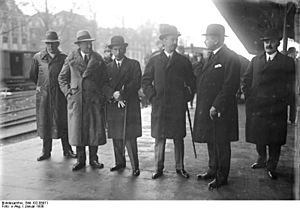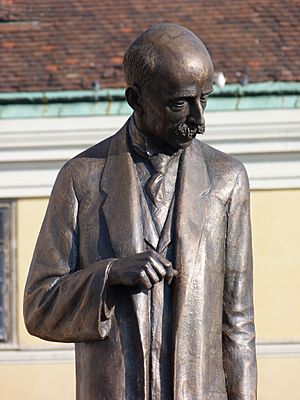István Bethlen facts for kids
Quick facts for kids
István Bethlen
de Bethlen
|
|
|---|---|
 |
|
| Prime Minister of Hungary | |
| In office 14 April 1921 – 24 August 1931 |
|
| Regent | Miklós Horthy |
| Preceded by | Pál Teleki |
| Succeeded by | Gyula Károlyi |
| Member of the House of Representatives | |
| In office 31 October 1901 – 16 November 1918 |
|
| In office 18 February 1920 – 2 February 1939 |
|
| Personal details | |
| Born | 8 October 1874 Gernyeszeg, Kingdom of Hungary (now Gornești, Romania) |
| Died | 5 October 1946 (aged 71) Moscow, Soviet Union (now Russian Federation) |
| Political party | Liberal Party (1901–1903) Party of Independence and '48 (1904–1913) National Constitution Party (1913–1918) Christian National Union Party (1919–1922) Unity Party (1922–1935) |
| Spouse | Countess Margit Bethlen de Bethlen |
| Children | András István Gábor |
| Profession | Politician, jurist |
Count István Bethlen de Bethlen (born October 8, 1874, in Gernyeszeg – died October 5, 1946, in Moscow) was an important Hungarian leader. He came from a noble family and was a skilled statesman. He served as the Prime Minister of Hungary for a long time, from 1921 to 1931.
Contents
Early Life of István Bethlen
István Bethlen was born into an old noble family called Bethlen de Bethlen from Transylvania. He was the only son of Count Istvan Bethlen de Bethlen and Countess Ilona Teleki de Szék. He also had two older sisters named Klementine and Ilona.
Political Career and Leadership
Starting in Politics
István Bethlen began his political journey in 1901. He was elected to the Hungarian parliament as a member of the Liberal Party. This was the start of his long career in public service.
Representing Hungary Abroad
After World War I, Bethlen represented the new Hungarian government. He attended the Paris Peace Conference in 1919. This meeting was held to decide the future of Europe after the war.
Dealing with Political Change
In 1919, Hungary faced big changes. A weak government collapsed and was replaced by a communist government. This new government was led by Béla Kun. Bethlen quickly returned to Hungary to lead an anti-communist government. He worked with Admiral Miklós Horthy in this effort.
Forming a Strong Government
Once the anti-communist forces took control, Miklós Horthy became the Regent (a temporary ruler). Horthy asked Bethlen to form a strong government. This was to prevent any more threats to the new country. Bethlen then created the Party of National Unity.
Uniting Different Groups
Bethlen was very good at bringing people together. He managed to unite two powerful groups in Hungary. These were the wealthy industrialists in Budapest and the traditional landowners in the countryside. This unity helped stop the rise of extreme political groups for about ten years. He also worked with labor unions, getting their support for his government.
Facing Political Challenges
In 1926, Bethlen faced a political challenge. There was a plot involving Hungarian nationalists who tried to harm the French economy. Some people involved in the plot suggested Bethlen had a role in it. However, Bethlen managed to control the situation and keep his position. He even became more popular in Hungary after this event.
Hungary on the World Stage
During his ten years as Prime Minister, Bethlen helped Hungary join the League of Nations. This was an international organization aimed at promoting peace. He also formed a close alliance with Italy. This was done to help Hungary regain some of the territory it lost after World War I.
Treaty of Trianon and Its Impact
Bethlen tried hard to change the Treaty of Trianon. This treaty was signed after World War I and took away much of Hungary's land. However, he was not successful in changing it.
End of His Time as Prime Minister
The Great Depression (a worldwide economic crisis) affected Hungary greatly. It led to a shift towards extreme right-wing politics. Because of this, Horthy replaced Bethlen as Prime Minister. First, Gyula Károlyi took over, followed by Gyula Gömbös, who had more extreme views.
Opposition to Nazi Germany
Even after leaving office, Bethlen remained an important voice. He was one of the few Hungarian leaders who strongly opposed an alliance with Nazi Germany. As World War II was ending, he tried to make a separate peace deal with the Allied powers. However, he was not successful.
Arrest and Death
By the spring of 1945, Soviet troops had taken over most of Hungary. The communists, who came with the Soviets, saw Bethlen as a threat. They worried he could unite people against them. In March 1945, the Soviets arrested him. He was taken to Moscow, where he died in prison on October 5, 1946.
Personal Life and Family
On June 27, 1901, István Bethlen married his distant cousin, Countess Margarete Bethlen de Bethlen. She was an author. They had three sons together:
- Count András Bethlen de Bethlen (1902–1970)
- Count István Bethlen de Bethlen (1904–1982)
- Count Gábor Bethlen de Bethlen (1906–1981)
See also
 In Spanish: Esteban Bethlen para niños
In Spanish: Esteban Bethlen para niños



